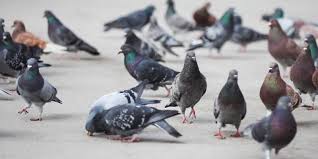Invasive birds have always had a presence in and around commercial facilities. For years they were viewed as just part of the ‘landscape’ of a grocery store, food distribution warehouse or food processing facility.
Closer Regulatory Scrutiny
Under mandates of the Food Safety and Modernization Act (FSMA) and closer scrutiny from auditors and inspectors, invasive bird activity is increasingly on the radar screen for auditors, especially in food processing facilities.
Keith Rowney, Sprague Pest Solution’s manager of bird control services and a certified bird control specialist, shared insights on how to prevent invasive birds from threatening their facilities.
“Invasive birds are very adaptable, smart and will travel miles between food sources,” said Rowney. “It takes a deep toolbox to achieve and maintain control.”
Bird control is not a one-off event, it is a process that includes:
- Identifying the species correctly
- Evaluating the site for conducive conditions and level of infestation
- Developing a control program based on the evaluation
- Implementing the program with agreement from management
“The degree of the infestation will dictate what control efforts are needed,” said Rowney. “It is also necessary to ‘stack the effects’ by combining various control strategies and continually re-evaluate your approach as circumstances warrant.”
Birds do not start out as habituated to a facility. The level of the birds’ commitment to roost in and around a facility will increase over time as a function of available resources (i.e. food, shelter, etc.) and the absence of an effort to address the developing infestation.
Correct Species Identification is Important
Following a correct identification of the species, it is critical to measure bird pressure. The level of pressure will also reveal the degree of commitment birds have to a facility. It is important to note that in higher pressure levels more effort and resources will be required to solve the problem.
- Low Pressure – Birds do not regularly roost at the facility; usually they just rest there.
- Medium Pressure – Birds routinely come to the facility looking for food or to roost.
- High Pressure – Birds are entrenched at the facility and roosting and nesting.
How do invasive birds become a problem in commercial facilities? Rowney said it sometimes is a lack of awareness of the consequences of bird infestations by management but in many cases a failure to act decisively and with a plan.
Stack the Effects
An effective plan starts with a commitment to prevent invasive birds from roosting in and around a structure.
Rowney said prevention is one of the most underused strategies in invasive bird control. What strategies are included in an effective invasive bird prevention program?
- Building design – elimination of ledges, nesting sites, exposed beams
- Use of rapid close doors
- Protection for pallets and garbage areas
- Proper grading of parking lots to eliminate standing water
- Select landscaping shrubs and trees that do not attract birds such as fruit trees and seed-bearing plants
Sanitation is another critical element in preventing invasive birds from establishing nesting locations in a structure. Regular clean-up of food, water spills and improved garbage and recycling protocols (i.e. keeping dumpster lids closed, placing them away from doors, etc.) are key.
Another required element of a successful invasive bird prevention program is observing and changing employee behaviors. Do they leave the lids off garbage cans or forgot to close dumpster lids? Do employees feed the birds on their break or lunch hour?
Rowney says it is vital that management educate and train employees on the importance of preventing invasive birds from becoming a problem and what role they can play in achieving that goal.
“Prevention is the first and, in some cases, most important step in reducing the threat of invasive birds in and around a commercial structure,” said Rowney. “Birds are amazingly adaptive creatures and are influenced greatly by human behavior. Investing the time and resources in a comprehensive prevention program will save you headaches and money in the long run.”
For more information on how Sprague Pest Solutions can assist you design and implement an effective invasive bird management program for your facility, call 855.805.0755.

